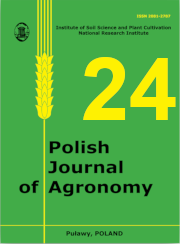YIELD AND QUALITY OF POTATO TUBERS AS AFFECTED BY FERTILISATION INVOLVING THE USE OF SOIL-INCORPORATED AND FOLIAR COMMERCIAL FERTILIZER PRODUCTS
Main Article Content
Abstract
In the years 2013–2015 field experiments on light soil were carried out on the impact of sea algae extract-based multicomponent fertilizers produced on yield and some quality of potato tubers compared to that of conventional fertilizers. Multicomponent fertilizer EUROFERTIL 33N-PROCESS containing NPK (8-3,5-14,1) supplemented with foliar application of liquid fertilizers FERTILEADER AXIS (with manganese and zinc), FERTILEADER GOLD (with boron and molybdenum) and a universal complex fertilizer. The action of the soil-applied application complex fertilizer (EUROFERTIL 33N-PROCESS) in conjunction with foliar application was compared to that of the standard NPK fertilizers: ammonium nitrate, superphosphate and potassium salt supplemented by foliar fertilizers (FERTILEADER AXIS and FERTILEADER GOLD). The control was the object treatment with of involving soil single fertilizers supplemented with universal multicomponent foliar fertilizer. The study showed the largest increase of tuber yield following the application of EUROFERTIL 33N-PROCESS supplemented with foliar fertilizers FERTILEADER AXIS and FERTILEADER GOLD. The use of EUROFERTIL 33N-PROCESS and FERTILEADER AXIS and FERTILEADER GOLD contributed to a significant increase in the percentage of large tubers (with a diameter above 60 mm) in the total tuber yield, increased starch content, dry matter and vitamin C as compared to control object. The treatment involving EUROFERTIL 33N-PROCESS with FERTILEADER GOLD resulted in a significant reduction in the level of nitrates in tubers as compared to that in the control treatment.
Article Details

This work is licensed under a Creative Commons Attribution-ShareAlike 4.0 International License.
The author grants the editorial staff of the Polish Journal of Agronomy (abbreviated as PJA) a non-exclusive and royalty-free license to use the author's copyright in the paper/printed and electronic versions of his/her work published in PJA in Poland and abroad, in whole or in any part, including placing the work in electronic databases/databases locally or available on the Internet, for an unlimited period of time in the fields of exploitation specified in article 50 of the Copyright and Related Rights Act.
Manuscripts published in Polish Journal of Agronomy are available under a Creative Commons Attribution-ShareAlike 4.0 (CC-BY-SA) license.

